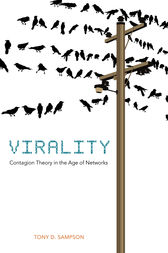The cover of Tony D. Sampson’s Virality: Contagion Theory in the Age of Networks incorporates the image of a flock of crows sitting on power lines, a scene with the potential to inspire the type of fear captured by films like Alfred Hitchcock’s The Birds (1963). While Sampson does not examine avian behavior, emotions like fear and the encounters in which they are produced constitute an essential part of this text’s overarching argument. In Virality, Sampson proposes that biological explanations of virality insufficiently explain the movement and effects of contagions. Memetics and the work of Émile Durkheim are two such explanations that distinguish between the biological and the social in what Sampson regards as an unproductive and unrealistic manner. In contrast, Sampson balances contagions’ productive opportunities with the threats that they pose by integrating these two fields. Because of this altered emphasis, Virality participates in a growing scholarly trend within the humanities in which researchers criticize and propose alternatives to the reification of a methodological division between biology and culture.[1] While dense
Claire Barber is a doctoral candidate at the University of Illinois at Urbana-Champaign. Her dissertation, entitled “Modern Cognitive Styles: The Aesthetics of Autism and Modernism,” proposes that a new literary genre emerges in the late twentieth–century whose texts employ similar avant-garde aesthetic and poetic strategies while representing a form of information processing that differs from conventionally accepted cognitive styles.

